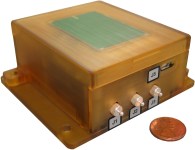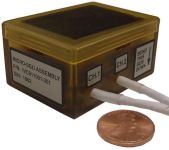
July 4 – July 17, 2006
Space Shuttle Discovery
This was the twenty-first flight of Invocon hardware on the Space Shuttle and the second mission after the loss of Columbia. As the second mission of the Return to Flight initiatives NASA continued testing new techniques and systems for detecting impacts and damage caused by debris during ascent.
Below is a list of the IVC systems that were present on Discovery during the mission. The EWB MicroTAU-WLE system is the IVC system used for detecting impacts on the leading edge of the Orbiter’s wing.
| 44 | EWB MicroTAU™ | Wing Leading Edge |
| 3 | WSGIS | Shuttle Arm |
| 4 | IWIF-WIS | Shuttle Arm Work Platform |
| 12 | MicroSGU™ | Aft Section |
Enhanced Wide-Band Micro-Miniature Tri-axial Accelerometer Unit

This is the second flight of the EWB MicroTAU system, a high-speed data acquisition network for dynamic acceleration sensing and recording. On STS-121, 44 units were used to detect, locate, and characterize impacts on the RCC panels on the wing leading edge.
Click here for more information about the EWB-MicroTAU system.
Micro-Miniature Strain Gauge Unit

One Invocon MicroSGU™ sensor is installed in the engine compartment to measure the stresses imparted to the trunnion arms on the Space Shuttle Main Engines (SSMEs).
Click here for more information about the MicroSGU system.
Mission Navigation
